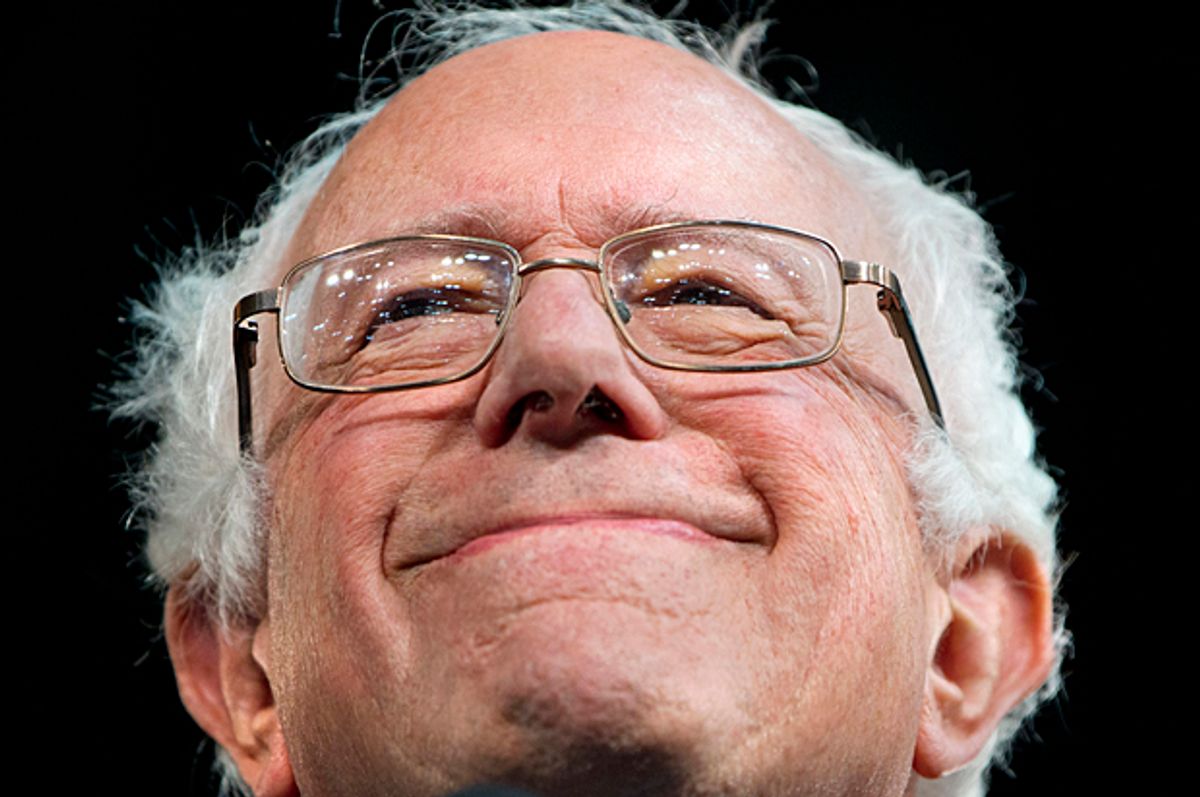Supporting Bernie Sanders is a heady mix of emotions, like being in an on-again, off-again relationship.
Things were good last weekend. Sanders won Washington, Alaska and Hawaii in what would be the best performing day of his campaign thus far, but the road ahead remains long and filled with speed bumps. And by speed bumps, I mean Sanders’ delegate deficit.
Sanders currently trails Hillary Clinton by 228 pledged delegates; 2,383 delegates are required to win the Democratic nomination, which means Sanders will need 998 more. Put another way, in order to “take things to the next level” with Sanders, he needs slightly less than 57 percent of the remaining delegates’ pledged support.
Basically, in an optimistic future where they make a film about Bernie Sanders’ road to victory, right about now would be a good moment for that Rocky-style montage.
"We are certainly in this to win it," Sanders campaign manager Jeff Weaver said earlier this week to press, "and there is a path to do so." Strong words from Bern’s man in the corner, but does he have the support to back it up?
The Sanders campaign has received more than $4 million in donations since Saturday. So it’s clear that when it comes to popular support, there’s no shortage of people feeling the Bern. The real question is, whether that fever can extend to those 998 delegates.
Earlier today, famed statistician Nate Silver (currently the editor-in-chief of ESPN's FiveThirtyEight blog and a special correspondent for ABC News) offered up his calculations mapping out Bernie’s miracle path to victory. Disregarding the remaining likely Sanders-friendly states (such as Oregon, Rhode Island, West Virginia and Montana), the real fight, according to Silver, will come down to the states with the bulk of the remaining delegates: namely, California, New York, Pennsylvania, New Jersey and Maryland. According to the polls, it’s going to be a real tough couple rounds for Sanders.
Then again, polls aren’t everything.
In a Huffington Post article, Seth Abramson pointed to the shift in Sanders’ support on voting days. Abramson cited the Democratic primary in Florida, which saw 18 percent of voters change their minds in favor of Sanders, according to exit polls.
“The point here,” said Abramson, “is that Hillary Clinton has been losing the primary for a month now in votes cast after the race began to favor Sanders on March 5th. This means that most of the projections the media is making about how Bernie Sanders will do going forward are based on election results, exit polls, and voter surveys compiled before that critical March 5th date.”
Looking at the numbers, New York has Sanders polling at a paltry 29 percent. Taken together with Pennsylvania and Maryland, if the decision came down to these numbers, Sanders would be out of the race today. As Silver notes, “to reach a pledged delegate majority, Sanders will have to win most of the delegates from those big states. A major loss in any of them could be fatal to his chances. He could afford to lose one or two of them narrowly, but then he’d need to make up ground elsewhere—he’d probably have to win California by double digits, for example.”
As things currently stand, predicting the outcome of the remaining race seems less a war of numbers than of narratives. One story has Clinton only furthering her lead, particularly in states like New York, where her “trusted, reliable brand” trades well with minority voters. Given this scenario, Clinton could go on to win the nomination by 400 to 500 pledged delegates, according to Silver.
Then there’s the Sanders-as-Stallone scenario. Here, we could potentially see Sanders gaining solid momentum in a number of the medium-sized states (Wisconsin, Indiana, Kentucky and New Mexico), bringing the gap close enough to allow for a down-to-the-wire finish in the bigger delegate-rich states.
Taking the numbers from Sanders’ original pledged delegate targets and adding in an optimistic couple extra, Silver created a “path-of-least-implausibility” to show what such a race might look like:

Silver went on to explain his logic behind these numbers. “It’s not hard to imagine Sanders meeting these super-optimistic projections in a few of the states,” he said, adding the inevitable proviso that Sanders would have to continue to win in the remaining states, or else greatly exceed expectations in New York and California.
It could happen. Just this week, the hashtag #BernieMadeMeWhite challenged the mainstream media narrative that has Clinton dominating Sanders among minority voters. In Silver’s prediction, there’s even room for existing superdelegates to shft their favor from Clinton to Sanders in upcoming weeks. In order for that to happen though, says Silver, “you might even say it would require a revolution, a profound rejection of Clinton and the status quo.”


Shares